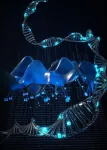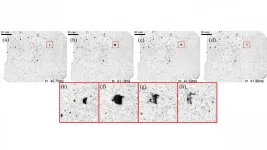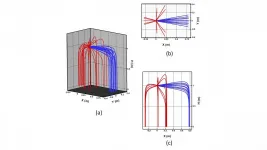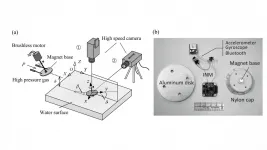INFORMATION:
Fixed network of smartphones provides earthquake early warning in Costa Rica
2021-04-20
(Press-News.org) Earthquake early warnings can be delivered successfully using a small network of off-the-shelf smartphones attached to building baseboards, according to a study conducted in Costa Rica last year.
In his presentation at the Seismological Society of America (SSA)'s 2021 Annual Meeting, Ben Brooks of the U.S. Geological Survey said the ASTUTI (Alerta Sismica Temprana Utilizando Teléfonos Inteligentes) network of more than 80 stations performed comparably to scientific-grade warning systems.
During six months' of ASTUTI operation, there were 13 earthquakes that caused noticeable shaking in Costa Rica, including in the city of San Jose where the network was deployed. The system was able to detect and alert on five of these earthquakes, Brooks and his colleagues determined when they "replayed" the seismic events to test their network.
Alerts for the system are triggered when shaking exceeds a certain threshold, equivalent to slightly less than what would be expected for a magnitude 5 earthquake, as measured by the accelerometers that are already built into the phones, Brooks said.
In simulations of the magnitude 7.6 Nicoya earthquake that took place in 2012 in Costa Rica, ASTUTI would have delivered its first alerts on average nine to 13 seconds after the event.
"The performance level over the six months is encouraging," Brooks said. "Cascadia events in the Pacific Northwest are similar to the Costa Rican subduction zone, and latencies for ShakeAlert in Cascadia are about 10 seconds, so it's comparable."
ASTUTI demonstrates the possibilities of lower-cost earthquake early warning for regions that lack the scientific-grade network stations such as those behind ShakeAlert, he noted.
"I would imagine that would be attractive for countries with less resources to dedicate to earthquake early warning" Brooks said, "but the performance is also at a level that I imagine would interest even wealthier countries."
The accelerometers within smartphones are ideal for a low-cost network, Brooks and his colleagues suggested. "If you were to build your own sensors, there's a lot of cost in maintaining them, and the sensors will quickly become obsolete," Brooks said.
By using commercial technology, "we let the big telecommunications companies do the research and development and we just deploy it," he added.
The phones were deployed in the homes of researchers and staff at the Observatorio Vulcanologico y Sismologico de Costa Rica (OVSICORI). The phones were enclosed in a plastic protective box before being mounted to the baseboard with 3M adhesive tape. As a result, the phones sense an earthquake through the filter of the structures, rather than directly as is the case for buried seismometers.
During testing, the system did not issue any false alerts. The researchers' analysis suggests the system could deliver alerts to 15% to 75% of Costa Rica's population in enough time to carry out drop-cover-hold-on responses, if it alerted the entire country after detecting an earthquake.
Country-wide alerting might be a successful strategy for the network, since recent studies show that people tend to be more tolerant than previously suspected of receiving warnings even if they didn't feel shaking, especially if they live in hazard-prone regions such as Costa Rica, said Brooks.
The work was funded by the U.S. Agency for International Development Bureau for Humanitarian Assistance. Next steps for ASTUTI will be to develop an app to make it more user-friendly and to deploy it more widely throughout the country.
Low-cost networks like ASTUTI will be a growing trend in earthquake early warning over the next decade, Brooks predicted. "When your objective is warning, you don't necessarily need the fanciest equipment."
ELSE PRESS RELEASES FROM THIS DATE:
Was Cascadia's 1700 earthquake part of a sequence of earthquakes?
2021-04-20
The famous 1700 Cascadia earthquake that altered the coastline of western North America and sent a tsunami across the Pacific Ocean to Japan may have been one of a sequence of earthquakes, according to new research presented at the Seismological Society of America (SSA)'s 2021 Annual Meeting.
Evidence from coastlines, tree rings and historical documents confirm that there was a massive earthquake in the U.S. Cascadia Subduction Zone on 26 January 1700. The prevailing hypothesis is that one megathrust earthquake, estimated at magnitude 8.7 to 9.2 and involving the entire tectonic plate boundary in the region, was responsible ...
Earthquakes continued after COVID-19-related oil and gas recovery shutdown
2021-04-20
When hydraulic fracturing operations ground to a halt last spring in the Kiskatinaw area of British Columbia, researchers expected seismic quiescence in the region. Instead, hundreds of small earthquakes occurred for months after operations shut down, according to a new study.
In her presentation at the Seismological Society of America (SSA)'s 2021 Annual Meeting, Rebecca Salvage of the University of Calgary said about 65% of these events could not be attributed to either natural seismicity or active fluid injection from hydraulic fracturing operations.
Salvage and her colleagues instead suggest the latent earthquakes may be the result of aseismic slip, driven by fluid from previous hydraulic fracture injections keeping rock pore pressures elevated.
"Because there are lots of faults ...
Back pain shows association with increased mortality risk in women
2021-04-20
BOSTON - New research from Boston Medical Center identifies elevated mortality risk for women with back pain when compared to women without back pain. Back pain was not associated with mortality among men indicating long-term consequences of back pain may differ by sex. The overall findings suggest that mild back pain (pain that does not keep a person from exercising or doing daily activities) is unlikely to impact the length of one's life, but risk of mortality was increased among adults with more severe back pain. Published in the Journal of General Internal Medicine, this new study raises ...
How lessons from past emergencies could improve the pandemic response
2021-04-20
The lack of accountability, poor communication and insufficient planning plaguing the government’s response to the COVID-19 pandemic -- especially in its early months -- have roots in how the nation responded to 9/11, Hurricane Katrina and the H1N1 swine flu, a new study involving the University of Washington found.
Focusing on the way government agencies assemble and allocate resources - the procurement system - researchers said the successes and shortcomings of responses to other large-scale crises show that a more centralized approach can achieve goals faster and more effectively.
"In the moment of disasters, we prioritize saving ...
'Information theory' recruited to help scientists find cancer genes
2021-04-20
Using a widely known field of mathematics designed mainly to study how digital and other forms of information are measured, stored and shared, scientists at Johns Hopkins Medicine and Johns Hopkins Kimmel Cancer Center say they have uncovered a likely key genetic culprit in the development of acute lymphoblastic leukemia (ALL).
ALL is the most common form of childhood leukemia, striking an estimated 3,000 children and teens each year in the United States alone.
Specifically, the Johns Hopkins team used "information theory," applying an analysis that relies on strings of zeros and ones -- the binary system of symbols common to computer languages and codes -- to identify variables or outcomes of a particular process. In the case of human ...
Newly discovered airway cells may shed light on SIDS and other conditions
2021-04-20
BOSTON - Recent research links certain cells that line the human airway with different infant diseases. The work, which is published in Cell Reports and was led by investigators at Massachusetts General Hospital (MGH), could lead to new prevention and treatment strategies for these conditions.
The human airway--from the windpipe to the lungs--is lined with epithelial cells, including a type called pulmonary neuroendocrine cells (PNECs) that communicate with the nervous system and secrete different factors and hormones. Increased numbers and clusters of PNECs have been observed in various breathing-related illnesses, but the cells' roles in health ...
Reversal of blood droplet flight predicted, captured in experiments
2021-04-20
WASHINGTON, April 20, 2021 -- Forensic science includes the analysis of blood backspatter involved in gunshot wounds, but scientific questions about the detailed role of fluids in these situations remained unresolved.
To search for answers about how blood droplets from a gunshot wound can reverse direction while in flight, University of Illinois at Chicago and Iowa State University researchers explored the influence of propellant gases on blood backspatter.
In Physics of Fluids, from AIP Publishing, the researchers report using numeric modeling to capture the behavior of gun muzzle gases and predict the reversal of blood droplet flight, which was captured experimentally. Their experiments also show the breakup of blood droplets, ...
Forensics puzzle cracked via fluid mechanical principles
2021-04-20
WASHINGTON, April 20, 2021 -- In 2009, music producer Phil Spector was convicted for the 2003 murder of actress Lana Clarkson, who was shot in the face from a very short distance. He was dressed in white clothes, but no bloodstains were found on his clothing -- even though significant backward blood spatter occurred.
How could his clothing remain clean if he was the shooter? This real-life forensic puzzle inspired University of Illinois at Chicago and Iowa State University researchers to explore the fluid physics involved.
In Physics of Fluids, from AIP Publishing, the researchers present theoretical results revealing an interaction of the incoming vortex ring of propellant muzzle gases with backward blood spatter.
A detailed analytical theory of ...
Certain gut microbes make mosquitoes more prone to carry malaria parasite
2021-04-20
Dietary sugars and gut microbes play a key role in promoting malaria parasite infection in mosquitoes. Researchers in China have uncovered evidence that mosquitoes fed a sugar diet show an increased abundance of the bacterial species Asaia bogorensis, which enhances parasite infection by raising the gut pH level. The study appears April 20 in the journal Cell Reports.
"Our work opens a new path for investigations into the role of mosquito-microbiota metabolic interactions concerning their disease-transmitting potential," says co-senior study author Jingwen Wang of Fudan University in Shanghai, China. "The results may also provide useful insights for the development of preventive strategies for vector ...
Stone skipping techniques can improve reentry of space vehicles
2021-04-20
WASHINGTON, April 20, 2021 -- Skipping stones on a body of water is an age-old game, but developing a better understanding of the physics involved is crucial for more serious matters, such as water landings upon reentry of spaceflight vehicles or aircrafts.
In Physics of Fluids, by AIP Publishing, scientists from several universities in China reveal several key factors that influence the number of bounces a skipping stone or landing aircraft will undergo when hitting the water.
The study involved theoretical modeling and a simple experimental setup using a model stone to gather data in real time. The investigators used an aluminum disk as a stand-in for the stone and designed a launching mechanism that utilized a puff of air from a compressor ...



